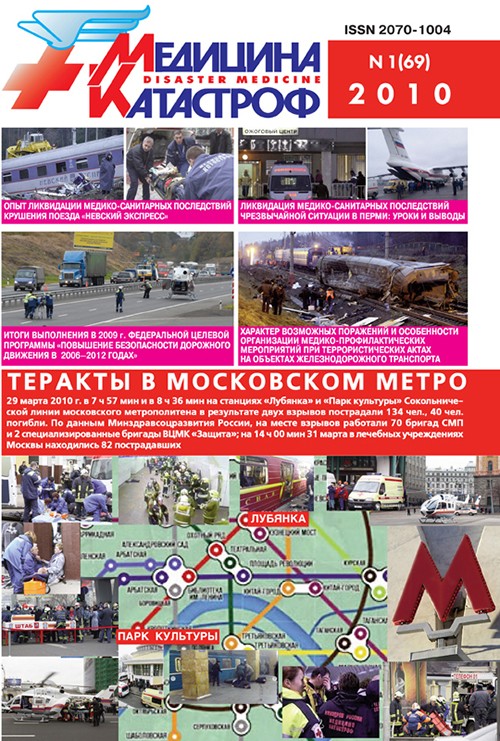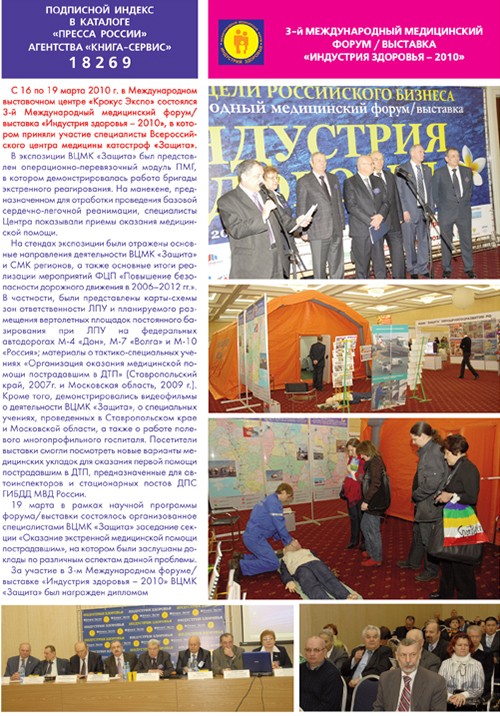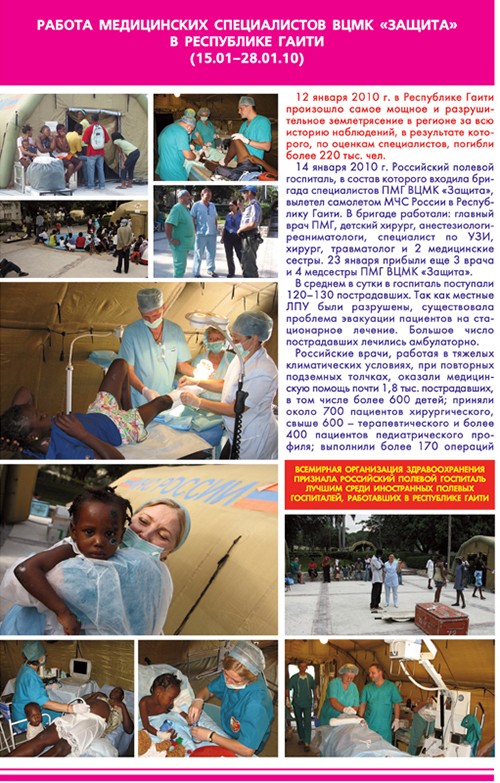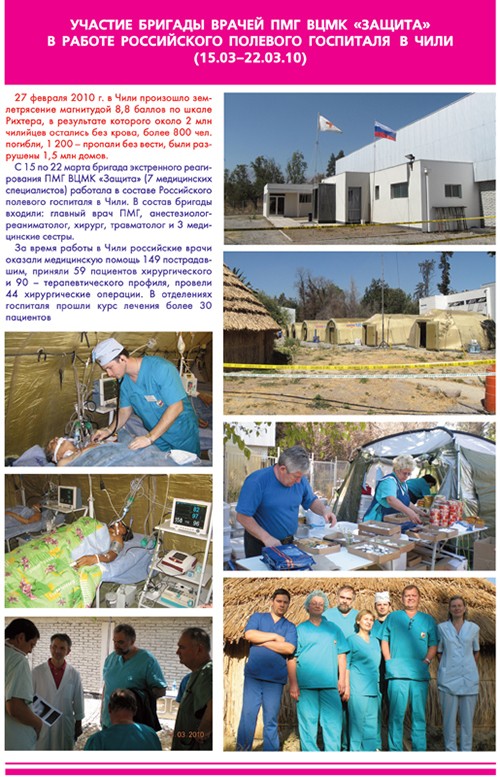ORGANIZATION AND TACTICS OF DISASTER MEDICINE SERVICE
1. Goncharov S.F., Avetisov G.M. The Main Directions of Enhancement of Preparedness of All-Russian Service for Disaster Medicine for Medical Recovery from Radiation Accidents
The results of elaboration by territorial centers for disaster medicine of medical support plans in event of radiation accidents are summed up. It is stated that the accomplishment of the work is hindered by the fact that the concept of All-Russian Center for Disaster Medicine «Zaschita» on radiation hazard up to 1 000 km from functioning nuclear power plants is not yet reflected in federal-level norms. The main directions of further enhancement of preparedness of All-Russian Service for Disaster Medicine, and first of all of its territorial structures, for medical recovery from radiation accidents are presented. The amendment of main tasks and functions of Ministry of Health and Social Development of Russia when coping with search and rescue and emergency work in radiation accident zone is discussed.
Key words: All-Russian Service for Disaster Medicine, medical and sanitary consequences, medical care of population, radiation accidents
2. Bojko N.V., Fisun A.Ya. Experience of Liquidation of Medical and Sanitary Consequences of Nevsky Express Train’s Crash
The experience of liquidation of medical and sanitary consequences of the train crash is presented. The data on the total number of victims and on medical care to casualties are given. It is noted that the liquidation of medical and sanitary consequences of the crash was carried out in two stages and their substance is discussed. The management of treatment and evacuation is analyzed.
Key words: manpower and resources, medical evacuation, Nevsky Express train’s crash, perished, stages of the liquidation of medical and sanitary consequences, wounded
3. Fisun A.Ya., Fedotkin O.V., Sukhorukov A.A. Liquidation of Medical and Sanitary Consequences of Emergency Situation in Perm: Lessons Learned and Conclusions
The process of liquidation of medical and sanitary consequences of emergency situation, Perm night club fire of 4–5 December, 2009. A detailed analysis of the treatment-and-evacuation measures is done. The information on number of casualties evacuated to hospitals of different cities, on personnel and resources involved in the management of the emergency is given. Treatment methods and their results are described.
Key words: aeromedical evacuation, casualties, emergency situations, fires, hospitals, liquidation of medical and sanitary consequences, Perm, territorial centers for disaster medicine, treatment methods and their results
4. Shabanov V.Eh., Boyko N.V., Krasnov S.A., Zaytseva S.N. Specifics of Organization of Medical Care Rendering to Victims of Catastrophic Earthquakes in Haiti and Chile
The specific features of medical care rendering organization at the Russian field hospital during the liquidation of medical and sanitary consequences of the devastating Haiti and Chile earthquakes are considered. The results of work of the hospital in these countries are presented.
Key words: casualties, devastating earthquake, organization of medical care rendering, Russian field hospital, the Republic of Haiti, the Republic of Chile
5. Kaptsov V.A., Kulbacinskiy V.V., Bazaz’yan A.G., Romanov V.V., Semenchukov A.V. Probable Injuries and Specifics of Preparedness Planning for and Management of Acts of Terrorism on Railways
The character of probable consequences of acts of terror with use of different destruction means (explosive devices, dangerous chemicals, chemical or biological agents, ionizing radiation sources) and specifics of preparedness planning for and management of such acts on railway passenger facilities are discussed in the article. The information on probable medical-sanitary consequences of the acts as well as on personnel and means; urgent organization, technical, treatment, prophylactics, sanitary and hygiene measures involved in liquidation of them is presented.
Key words: acts of terrorism, casualty collection points, medical and prophylactics measures, medical-sanitary consequences, railway facilities
6. Borisenko L.V., Shilkin I.P. Directions of Development of Automated Information and Control System of All-Russian Service for Disaster Medicine
The main results of work on elaboration of automated information and control system of All-Russian Service for Disaster Medicine are presented. A detailed analysis of the priority directions of its development is done. The reasons why the work on elaboration and development of the system is not yet efficient are pointed out.
Key words: All-Russian Service for Disaster Medicine, automated information and control system, medical support of population in emergency situations, modern information technologies
CLINICAL ASPECTS OF DISASTER MEDICINE
7. Aleksandrovich Yu.S., Pshenisnov K.V., Cherevatenko R.I. Neurosurgical Care Rendering to Children in Resuscitation and Intensive Care Units of Central District General Hospitals
Acute brain injuries are among the most frequent critical conditions in children in resuscitation and intensive care units of central district general hospitals particularly in emergency situations. It is not always possible to render adequate neurosurgical care under the conditions. The authors evidentiate the high efficiency of a pattern of such care delivery by a mobile pediatric neuroresuscitation team including a neurosurgeon with expertise in handling children.
Key words: acute brain injury, children, critical condition, evacuation, neurosurgical care, resuscitation and intensive care units of central district general hospitals
8. Gundorova R.A., Kvasha O.I., Feraizi Eh. Eyelid Wounds Treatment with NO-Containing Gas Flow (Experimental Study)
The study of influence of NO-containing gas flow on eyelid wound process is given coverage. Healing of incised wounds of eyelids in twenty rabbits is studied. The use of air-plasma apparatus «Plazon» in the biostimulation mode as the source of gas flow is described.
Key words: air-plasma apparatus «Plazon», eyelid wound, nitric oxide, NO-therapy
9. Batrak Yu.M., Yepifantsev A.G., Ratkin I.K. Algorithm of Health Care Delivery to Victims with Complicated Spinal Cord Traumas
The algorithm elaborated for the first time ever of health care delivery to victims with complicated spinal cord traumas at prehospital and specialized surgery stages is suggested. Clinical proofs of dependence of functional rehabilitation of complicated trauma cases on delay in surgery are provided.
Key words: complicated spinal cord traumas, evacuation, operative therapy, rehabilitation
10. Shevtsova O.A., Kokhanov V.P. Peculiarities of Initial Changes of Mental Health Status of Servicemen of Russian Special Services
The results are presented of the study of characteristics of preclinical forms of psychic disorders at a neurotic level in Russian special services personnel. It is shown that at the initial stage of exposure to extreme situations, besides some «ruder» forms of psychological reaction, functional cognitive disorders occur more often and significantly earlier than other psychic disorders.
A conclusion is drawn that psychic disorders detected in servicemen show a definite stereotype in their development: from pathological psychology to psychological pathology with stabilization tendency: from episodic disorders to steady disorders at a neurotic level. The clinical implications of the disorders involve all the spheres of psyche: emotional, cognitive, somatovegetative and behavioral.
Key words: mental health status, psychic disorders at a neurotic level, Russian special services personnel
11. Stukanov M.M., Girsh A.O., Lukach V.N., Khrapov S.A., Volkova K.G., Gorin P.A. Informativity of Diagnostic Criteria of Wound Shock Complicated by Blood Loss at Prehospital Stage
Informativity of diagnostic criteria of wound shock complicated by blood loss at prehospital stage is presented. It is found that complicated grade 1 wound shock can be diagnosed with high frequency of truly positive results with the help of such sensitive and specific criteria as systolic and average arterial pressure, heart rate, index of Algover, as well as central venous pressure level. To diagnose complicated grade 2 wound shock clinical symptoms such as pallor, cold skin, empty subcutaneous veins should be added to the above-mentioned criteria.
Key words: diagnostics of wound shock, informativity of criteria, prehospital stage, severe blood loss
12. Kaplun V.A. Treatment of Distal Tibia Fractures in Casualties of Emergency Situations
The reduction of transfer time of casualties with bifocal fractures and distal tibia injuries to traumatological hospital to 1,5 hours and appropriate treatment at prehospital stage help to avoid shock development. Osteosynthesis was managed in 38 (40.9 percent) treated cases within 0,5–1,5 hours. In 55 (59.1 percent) patients admitted to hospital in shock condition and patients with open fractures surgical intervention took place 14–20 days later, after functional compensation. Rehabilitation efficiency is substantially higher when surgical intervention happens within a few hours after the accident.
Key words: casualties, distal tibia, emergency situations, fractures, osteosynthesis, rehabilitation
MEDICAL ASPECTS OF ROAD TRAFFIC SAFETY
13. Goncharov S.F., Borisenko L.V., Bobij B.V., Akin’shin A.V., Shuvalova E.A. Results of Fulfillment of Federal target program «Increased traffic safety for 2006–2012» in 2009
The results of fulfillment of the Federal target program «Increased traffic safety for 2006–2012» by institutions of the Ministry of Health and Social Development of the Russian Federation in 2009 are presented. The main directions of the Program provisions realization are considered: education and training of drivers and other participants of liquidation of consequences of traffic accidents in technique of first aid delivery; preparation of instructors for teaching drivers and other participants of liquidation of consequences of traffic accidents in technique of first aid delivery; perfection of use of helicopters and aeromedical evacuation for emergency medical care of traffic accident victims and so on.
Key words: casualties, education and training of drivers, expert-consultative and evacuation system of specialized medical care delivery, Federal target program «Increased traffic safety for 2006–2012», first aid, preparation of instructors, technical facilities of medical outfits, traffic accidents, use of helicopters
14. Kipor G.V., Goncharov S.F., Bessonov V.A., Ishkov A.V. Influence of Complex of Information-Ergonomic Factors on Psychophysiological Status of Drivers
Report 3. Driver Fatigue-Level Assessment Algorithm
Technologies of consecutive assessment of regulation status of functional asymmetry of cerebral hemispheres are given consideration. Quantitative criteria of different levels of fatigue are presented.
Key words: fatigue, functional asymmetry, functional status, inter-hemispheric asymmetry, levels of status assessment, mental processes, multivariate analysis methods, psychophysiological status diagnostics algorithm
15. Borisenko L.V., Koldin A.V., Akin’shin A.V. Elaboration and Adoption of Statistical Documentation Is One of Directions of Perfection of First Aid to Road Traffic Accident Casualties
A report form of statistics documentation «First Aid Registration Card» elaborated by the authors as well as the results of its adoption by a number of municipalities are presented. The use of primary records shows that the Card makes it possible to get a full-fledged picture of activity results of those involved in rendering first aid to road traffic accident victims.
Key words: First Aid Registration Card, first aid structure, first aid to road traffic accident
victims, road traffic accidents, statistics documentation, traffic police personnel
ACTUAL PROBLEMS OF SPECIALIZED (AEROMEDICAL) EMERGENCY MEDICAL CARE
16. Popov A.V., Baranova N.N., Garmash O.A. Problems of Creation of System of Aviation EMS Rendering to Population of Russian Federation
Different aspects (legal, financial, material and technical) of the problem of creation of a system of aviation emergency medical service rendering to the population of the Russia are considered. It is stressed that the problem is a multidimensional one and some ways of its solution are marked.
Key words: aviation EMS system, legal framework, logistical support, medical personnel training, population of Russia
EDUCATION AND TRAINING OF PERSONNEL
17. Zhukov V.A., Sakhno I.I., Ryabinkin V.V. Role and Tasks of All-Russian Center for Disaster Medicine «Zaschita» in Methodological Support of Medical Personnel Training for Disaster Medicine Service
The authors present the stages of development of system of postgraduate education of medical cadres of disaster medicine service, define role and tasks of ARCDM «Zaschita» in methodological support of disaster medicine teaching at medical higher education institutions and postgraduate courses, in setting up and development of chairs of health system mobilization readiness and disaster medicine chairs of medical higher education institutions. A role of education and methodic board on personnel training for disaster medicine service and for mobilization work of the Ministry of Health and Social Development is shown.
Key words: disaster medicine service, further professional education, medical cadres, methodological support
SHORT REPORTS
18. Rozhkov P.G., Ostapenko Yu.N., Prostakishin G.P. Toxic Effect of Combustion Products on Victims of Desember 4, 2009 Fire in Perm
INFORMATION
19. Filippov A.Yu. Aeromedical Evacuation of Casualties from Ingushetia
20. At Dissertation Board of All-Russian Center for Disaster Medicine «Zaschita»




